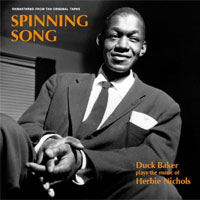Duck Baker • Spinning Song: Duck Baker Plays the Music of Herbie Nichols
 here’s a long tradition of solo acoustic guitarists valiantly
adapting ragtime and other syncopated piano music to the six-string fretboard. The piano
keyboard encompasses over seven octaves; acoustic guitar has maybe half that range. On
piano you can play two distinct lines fairly easily. On guitar, that may take some
head-scratching and finger-knotting: fitting one line into the cracks in the other. here’s a long tradition of solo acoustic guitarists valiantly
adapting ragtime and other syncopated piano music to the six-string fretboard. The piano
keyboard encompasses over seven octaves; acoustic guitar has maybe half that range. On
piano you can play two distinct lines fairly easily. On guitar, that may take some
head-scratching and finger-knotting: fitting one line into the cracks in the other.
We had a dramatic example of the practice recently. Miles Okazaki’s 2018 download album Work is all 70 Thelonious Monk tunes arranged for solo guitar, from a variety of perspectives. That epic eclipsed Duck Baker’s LP Plays Monk [Triple Point 271], out around the same time, although Baker may be our leading translator of problematic jazz piano music to finger-picked solo guitar -- going back to 1980, when he recorded Abdullah Ibrahim’s two-handed "Tintiyana." Baker’s no straight jazzist. He plays ragtime, several varieties of Anglo-American folk music, and he free improvises, on labels from Kicking Mule to Emanem. His 1996 CD Spinning Song came out on Japan’s/John Zorn’s now-defunct Avant label (though Baker will sell you a copy via his website). It showcases nine compositions by New York jazz composer/pianist Herbie Nichols, who recorded in trio for Blue Note and Bethlehem in the 1950s, and wrote terrific tunes, but didn’t begin to get his (posthumous) due until the 1980s, and still isn’t celebrated enough. His puckish, jaunty melodies had odd (and original) and often dissonant/wayward chord progressions that might swerve between major and minor. But his melodies are genial, listener-friendly, and he’d foreground the melody when he improvised, paraphrasing with a breezy rhythmic attitude that made every chorus sound fresh. Springy rhythm sections helped -- his drummers on record were Art Blakey, Max Roach and Dannie Richmond -- but the buoyancy came from the leader. Since its release in 1996, Spinning Song has become a personal favorite, and I confess that when I first reviewed it, I didn’t praise it quite enough, preoccupied with Baker slowing some tempos to make the tricky tunes more manageable. But the best tempo, as Count Basie knew, is the one that lets you swing most freely. And Baker really makes those memorable melodies sing: "The Third World," "House Party Starting" -- and especially "Portrait of Ucha," played with almost-flamenco lustiness, on the smaller-scale Mexican requinto guitar also used on "Nick at T’s." (Most of the pieces are played on nylon-string Spanish guitar.) Like a conventional jazz picker, Baker keeps the accompaniment going under the melody, though Nichols' bass lines avoid familiar patterns: the revolving figures under "The Happenings," the harmonically roving line under "117th Street" (incorrectly listed as "134th Street" on first release). Some of those pianistic runs don’t lie so readily on the fretboard -- a plummeting phrase in the middle of "The Spinning Song," say. But the guitarist gets that infectiously jaunty feeling. Not enough to play those beautiful melodies. Baker improvises on them too, taking them farther afield than Nichols did, and injecting bits of the melody into his solos to give listeners their bearings. The guitarist incorporates a couple of the little intros/outros with which Nichols framed his tunes, on "The Third World," fore and aft, and as a tag on "Lady Sings the Blues." Baker often catches the spirit of Herbie’s own idiosyncratic improvising, slowly working away from a melody while ever ready to dip back into it. On "117th," Baker juggles elements of the tune rhythmically during the blowing, embellishing but always keeping the tune (and initial mood) near at hand. He makes "2300 Skidoo" sound like real shuffling guitar music, keeping a walking bass line going much of the time -- and, crucially, sliding in and out of it without calling attention to the shift. His technique is clean, and recorded so you can hear every double-stopped harmony and quickly picked or flecked chord. On "Lady Sings the Blues" he pointedly leans on bent blue notes -- steel strings on that one -- and plays the Nichols bridge. (Billie Holiday altered it a bit when she set lyrics to it and made it her theme.) The original recording was digital, and Triple
Point’s Joe Lizzi mastered the LP from the original 24-bit/88.2kHz digital tapes.
Indeed, it sounds very like the old CD. Paul Gold cut the the lacquers at Salt Mastering
in Brooklyn. The 140-gram red see-through LP was manufactured at New Jersey’s
Independent Record Pressing. The sturdy sleeve includes an insert with Baker’s
original notes, in which he credits John Zorn for the idea, and a new essay in which he
redoubles his thanks to the late Nichols champion and trombonist Roswell Rudd, who liked Spinning
Song very much. It’s not cheap, but then not every solo album calls two maverick
talents to your attention. |
